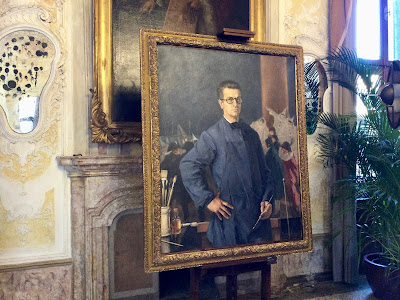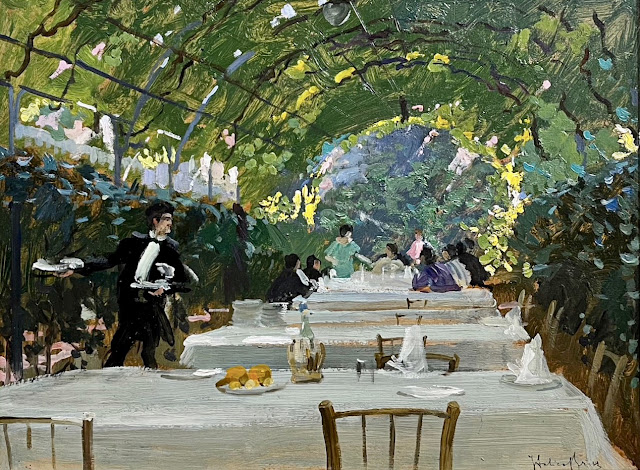 |
| Caffè Florian (detail) by Italico Brass (1912) |
(Venice, Italy) Italico Brass is the most delightful painter of Venice that you probably have never heard of. That's all about to change thanks to a gem of an exhibition in Palazzo Loredan in Campo Santo Stefano entitled Italico Brass, Il Pittore di Venezia.
The last time Italico Brass had his own show was back in 1948 at the Venice Art Biennale, the first Biennale after the fall of the Fascist regime.
Instead of painting the usual Venetian monuments, Brass captured the everyday lives and times of the inhabitants of Venice, the town that he had adopted as his home. Festivals and regattas. Votive bridges and holy days. The campi of Venice in sunshine and in snow. From gondoliers to lace-makers, cafés in Piazza San Marco to high-society on the Lido, Brass reminds us of how many precious elements of life in Venice once existed, some of which still exist to this day.
 |
| Due buranelle (Two women of Burano) by Italico Brass (c. 1904) |
Born on December 12, 1870 in the Northern Italian town of Gorizia when it was under Austrian domination, Brass wanted to be an artist from a young age. Family lore says that his father took him to the ancient Gorizia Castle and pointed far off in the distance, telling him stories about Venice, a city that became a fixation to the budding painter.
Brass studied at the Accademia di Belle Arti in Munich after proving his talent at age 16 by painting a portrait of his father. He then lived in Paris and frequented Impressionist and Post-Impressionist circles, where numerous exhibitions of his work were held. He also found success in various European cities and the Americas.
 |
| Italico Brass self-portrait (1928) inside Palazzo Loredan |
Brass arrived from Paris to the lagoon in 1895 with his new wife, Lina Rebecca Vidgoff, living first in Chioggia and then in Venice. He was present at the very first Venice Art Biennale in 1895, and in almost every edition until the year of his death in August 1943.
After that, he fell into oblivion except for one show in his home town of Gorizia in 1991.
Now, 80 years after Brass's death, Venice is launching her adopted son -- who had been called "The Painter of Venice" by critics since the early 20th century -- back into the spotlight.
 |
| Scuola di merletti (School of Lace) by Italico Brass |
What is fascinating about the exhibition is that Brass has captured the
stories we hear about Venice at the turn of the 20th century, and
brought them to life. Instead of reading about the revival of
lace-making on the island of Burano thanks to the efforts of Countess
Andriana Marcello, Brass was actually there on Burano in 1904. He spent
the summer with fellow artists Pieretto Bianco and Umberto Veruda, who
was a guest of the author Italo Svevo. Thanks to his brush we can
witness the women at work, making lace.
 |
| Conversazione sulla spiaggia (Conversation on the beach) by Italico Brass |
There is an enchanting series of paintings of the Lido that Brass painted during the first half of the 20th century as it developed
into a lively seaside resort. He captures wealthy visitors lounging on its shores as well as everyday
Venetians frolicking in the sea, scenes that still exist to this very day (with far less clothing) -- if you know where to look.
 |
| Pedicure, manicure, haircut right on the beach |
One of my favorite works was a small painting of the instantly recognizable interior of Locanda Montin over in Dorsoduro.
 |
| Sotto la pergola (Under the Pergola) by Italico Brass (c.1920) |
Next to the painting was a note that said:
Can you imagine such a trio at lunch?! Italico Brass lived in the house next to the Church of San Trovaso in Dorsoduro, not far from Pound and D'Annunzio.This is the pergola in the garden of the Locanda Montin frequented by Brass almost every day: here he met both D'Annunzio and Ezra Pound.
The notes from the exhibition state that "Brass did not belong to any school, current or other but, as the critics say, 'belonged to himself.' With these characteristics of originality and uniqueness, Italico Brass practically spanned the first half of the century, devoting himself mainly, but not exclusively, to portraying Venice and its world in new and, above all, modern terms."
Italico Brass died suddenly in Venice on August 16, 1943, the day of the Feast of San Rocco.
There are over 100 works on display inside Palazzo Loredan that whisk you back to Venice a century ago before the tourist invasion. After I left the exhibition, I stopped over in Campo San Maurizio to take a photo of the same image that Italico Brass painted in 1910.
 |
| El Campaniel, (bell tower) Campo San Maurizio left: 1910 oil on canvas by Italico Brass - right: 2023 iPad photo by Cat Bauer |
Italico Brass, The Painter of Venice is presented by the Istituto Venetio di Scienze, Lettere ed Arti and Lineadacqua, who also has published a beautiful accompanying catalogue -- in Italian, but with many gorgeous images that need no words to understand. There does seem to be a short guide in English that I haven’t seen. The main partner is Majer, who you can support by enjoying their delicious pastries and other goodies, along with the stalwart The Merchant of Venice with their exotic fragrances and art of perfumery.
Italico Brass, Il Pittore di Venezia curated by Giandomeico Romanelli and Pascaline Vatin runs from September 30 to December 22, 2023, and is a MUST SEE for anyone who truly loves Venice. The two curators also made a short film that gives an entertaining history in Italian with English subtitles. Go to the Institute of Science, Letters and Arts for more information.
UPDATE: After the exhibition closed, Andrea Brass, the grandson of Italico Brass, donated one of the most important paintings, Caffè Florian, to the Istituto Veneto di Scienze, Lettere e Arti after a long court battle over the estate with his famous filmmaker brother, Tinto Brass and other heirs. So, the marvelous oil remains in Palazzo Loredan in Campo Santo Stefano. You can see it if you make prior arrangements by emailing: cancelleria@istitutoveneto.it.
 | ||
| Andrea Rinaldo, President, Andrea Brass & Luca Zentilini of Linea d'Acqua with Caffè Florian by Italico Brass (1912) at donation ceremony Photo: Cat Bauer |
Ciao from Venezia,
Cat Bauer
Venetian Cat - The Venice Blog
Italico Brass is the most delightful painter of Venice that you probably have never heard of. That's all about to change thanks to a gem of an exhibition in Palazzo Loredan in Campo Santo Stefano entitled Italico Brass, Il Pittore di Venezia.
ReplyDelete